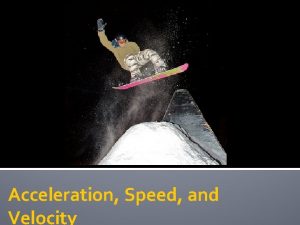6 1 Speed distance and acceleration Three main


- Slides: 2

6. 1 Speed, distance and acceleration Three main units of speed: ______ (km/h) Miles per hour (______) Metres per second (m/s) A cyclist accelerates from 0 to 10 m/s in 5 seconds. What is her acceleration? A car travels 65 miles in 2 hours. What is its speed? Calculating acceleration from graphs. How long does it take to go from 0 m/s to 8 m/s? Can you work out the acceleration? The _____ of the line in a distance–time graph equals the speed. 6 mark - split the graphs into separate sections to talk about. If there is an acceleration you can calculate, do it! Use uniform for straight lines, non-uniform for curves The distance travelled on a velocity-time graph can be calculated by working out the area under the graph. What is the area under the graph? -->

The total stopping distance = _____distance +_______ distance What happens to the thinking distance if you double the speed? What happens to the braking distance if you double the speed? What factors can affect your thinking distance? The stopping distance is much further for faster speeds, which is why you should: Keep your distance from the car in front, especially if the road conditions are poor and keep to the speed limit. What factors can affect your braking distance? Which factor affects both? What measures are put in place to increase road safety? Do you think that speed cameras are effective in reducing accidents? Thinking distance - It takes time for a driver to react to a situation. During this reaction time the carries on moving. The thinking distance is the distance travelled in between the driver realising he needs to brake and actually braking. Braking distance - The braking distance is the distance taken to stop once the brakes are applied.



